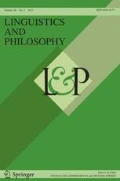Abstract
The purpose of this paper is to shed some light on the familiar puzzle of free indirect discourse (FID). FID shares some properties with standard indirect discourse and with direct discourse, but there is currently no known theory that can accommodate such a hybrid. Based on the observation that FID has ‘de se’ pronouns, I argue that it is a kind of an attitude report.
Similar content being viewed by others
References
Abusch D. (1997) Sequence of tense and temporal de re. Linguistics and Philosophy 20: 1–50 doi:10.1023/A:1005331423820
Altshuler, D. (2004). A simultaneous perception of things: SOT in Russian. Snippets 8.
Altshuler, D. (to appear). Narrative effects in Russian indirect reports and what they reveal about the meaning of the past tense. Proceedings of SALT 18.
Anand, P. (2006). De de se. Ph.D. dissertation. MIT.
Anand, P., & Nevins, A. (2004). Shifty operators in changing contexts. Proceedings of SALT XIV.
Banfield A. (1982) Unspeakable sentences. Routledge and Kegan Paul, London
Bobaljik J. (2008) Missing persons: A case study in morphological universals. Linguistic Review 25: 203–230
Borer, H. (1981). Heybetim leSoniyim Sel ha-maba ha-meSulav (Linguistic aspects of the combined discourse). ha-Sifrut, 30–31, 35–57.
Castañeda H.-N. (1966) “He”: A study in the logic of self-consciousness. Ratio 7: 130–157
Chierchia G. (1989) Anaphora and attitudes de se. In: Bartsch R., van Benthem J., van Emde Boas P. (eds) Semantics and contextual expression. Foris, Dordrecht, pp 1–31
Clements (1979) The logophoric pronun in Ewe: It’s role in discourse. Journal of West African Languages 10: 141–177
Cooper, R. (1979). The interpretation of pronouns. In F. Heny & H. Schnelle (Eds.), Syntax and semantics (vol. 10, pp. 61–92).
Cresswell M., von Stechow A. (1982) belief generalized. Linguistics andPhilosophy 5: 503–535 doi:10.1007/BF00355585
Doron, E. (1990). Point of view. CSLI/Stanford, Report No. CSLI-90-143.
Doron, E. (1991). Point of view as a factor of content. In S. Moore & A. Wyner (Eds.), Proceedings of SALT 1 (pp. 51–64). Cornell University.
Dowty D. (1982) Tense, time adverbs and compositional semantic theory. Linguistics and Philosophy 5: 23–55 doi:10.1007/BF00390692
Enç M. (1987) Anchoring conditions for tense. Linguistic Inquiry 18: 633–657
Heim, I. (1992). Anaphora and semantic interpretation: A reinterpretation of Reinhart’s approach. University of Tuebingen, SfS Report 07-93.
Heim, I. (1994). Comments on Abusch’s theory of tense. In H. Kamp (Ed.), Ellipsis, tense and questions, (pp. 143–170). DYANA deliverable R2.2.B, University of Amsterdam.
Heim, I. (2005). Features on bound pronouns. Ms., MIT.
Heim I., Kratzer A. (1998) Semantics in generative grammar. Blackwell, Oxford
Jespersen, O. (1931). A modern English grammar on historical principles, Part IV, syntax, third volume, time and tense. Heidelberg: Carl Winters Universitatsbuchhandlung.
Kamp H., Reyle U. (1993) From discourse to logic. Kluwer, Dordrecht
Kamp H., Rohrer C. (1983) Tense in texts. In: Bäuerle R., Schwarze C., Stechow A. (eds) Meaning, use and interpretation of language. de Gruyter, Berlin, pp 250–269
Kaplan D. (1977) Demonstratives. In Themes from Kaplan. Oxford University Press, Oxford
Kaplan D. (1979) On the logic of demonstratives. Journal of Philosophical Logic 8: 81–98 doi:10.1007/BF00258420
Kratzer, A. (1998). More structural analogies between pronouns and tenses. Proceedings of SALT, VIII, CLC. Publications, Cornell University.
Kratzer, A. (to appear). Making a pronoun. Linguistic Inquiry.
Lewis D. (1979) Attitudes de dicto and de se. The Philosophical Review 88: 513–543
Ogihara T. (1996) Tense, attitudes and scope. Kluwer Academic Publishers, Dordrecht
Partee B. (1973) Some structural analogies between tenses and pronouns in English. The Journal of Philosophy 70(18): 601–609 doi:10.2307/2025024
Percus, O., & Sauerland, U.(2003). On the LFs of attitude reports. In M. Weisgerber (Ed.), Proceedings of Sinn und Bedeutung 7, pp. 228–242. Universität Konstanz.
Potts, C. (2007). The dimensions of quotation. In C. Barker & P. Jacobson (Eds.), Direct compositionality (pp. 405–431). Oxford University Press.
Quine W.V.O. (1956) Quantifiers and propositional attitudes. The Journal of Philosophy 53: 177–187
Reinhart, T. (1991). Self-representation. manuscript.
Schlenker, P. (1999). Propositional attitudes and indexicality. PhD dissertation, MIT.
Schlenker P. (2003) A plea for monsters. Linguistics and Philosophy 26: 29–120 doi:10.1023/A:1022225203544
Schlenker P. (2004) Context of thought and context of utterance (a note on Free Indirect Discourse and the Historical Present). Mind & Language 19: 279–304 doi:10.1111/j.1468-0017.2004.00259.x
Schlenker, P. (2005). Comments on Sharvit’s “Embedded Pronouns”. Handout of talk presented at Syntax and Semantics with Attitude, April 2005, USC.
Schlenker, P. (to appear). Indexicality and Logophoricity. In K. von Heusinger, P. Portner, & C. Maienborn (Eds.), Handbook of semantics.
Sharvit Y. (2003a) Tense and identity in copular constructions.NaturalLanguageSemantics 11: 363–393 doi:10.1023/A:1025528225951
Sharvit Y. (2003b) Embedded tense and universal grammar. Linguistic Inquiry 34: 669–681 doi:10.1162/ling.2003.34.4.669
Sharvit, Y. (2004). Free indirect discourse and de re pronouns. In R. Young (Ed.), Proceedings of semantics and Linguistic Theory (SALT) 14 (pp. 305–322). CLC Publications, Cornell University.
von Fintel, K. (1994). Restrictions on quantifier domains. PhD dissertation, University of Massachusetts at Amherst, GLSA Publications.
von Stechow, A. (1995). On the proper treatment of tense. Proceedings of SALT 6.
von Stechow, A. (2003). Feature deletion under semantic binding: Tense, person, and mood under verbal quantifiers. Text of the NELS33 talk.
Zimmermann, E. (1991). Kontextabhängigkeit. In A. von Stechow & D. Wunderlich (Eds.), Semantik: ein internationals Handbuch der zeitgenössischen Forschung.
Author information
Authors and Affiliations
Corresponding author
Rights and permissions
About this article
Cite this article
Sharvit, Y. The puzzle of free indirect discourse. Linguist and Philos 31, 353–395 (2008). https://doi.org/10.1007/s10988-008-9039-9
Received:
Accepted:
Published:
Issue Date:
DOI: https://doi.org/10.1007/s10988-008-9039-9




